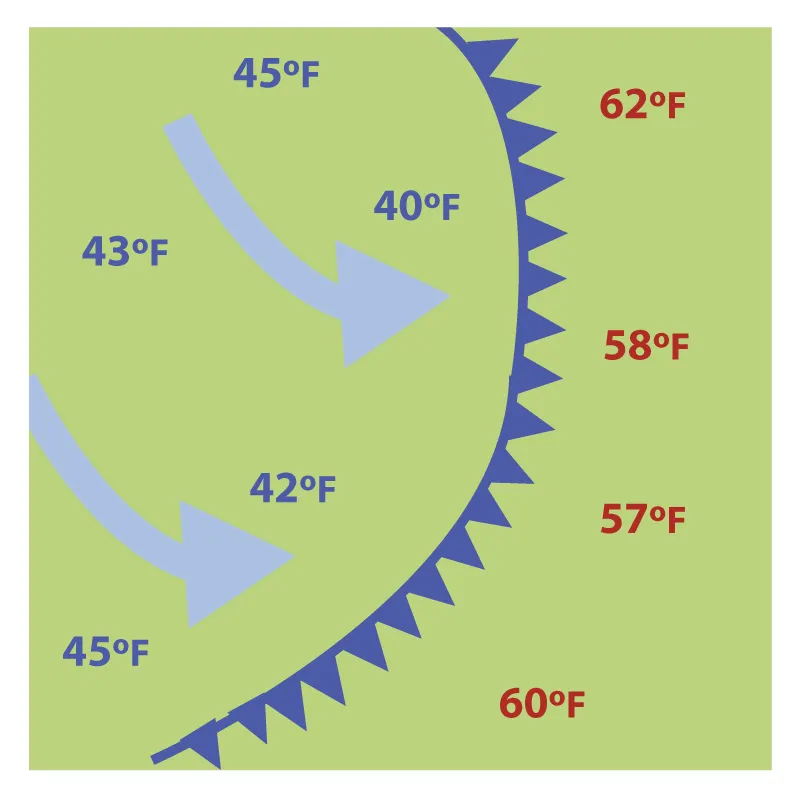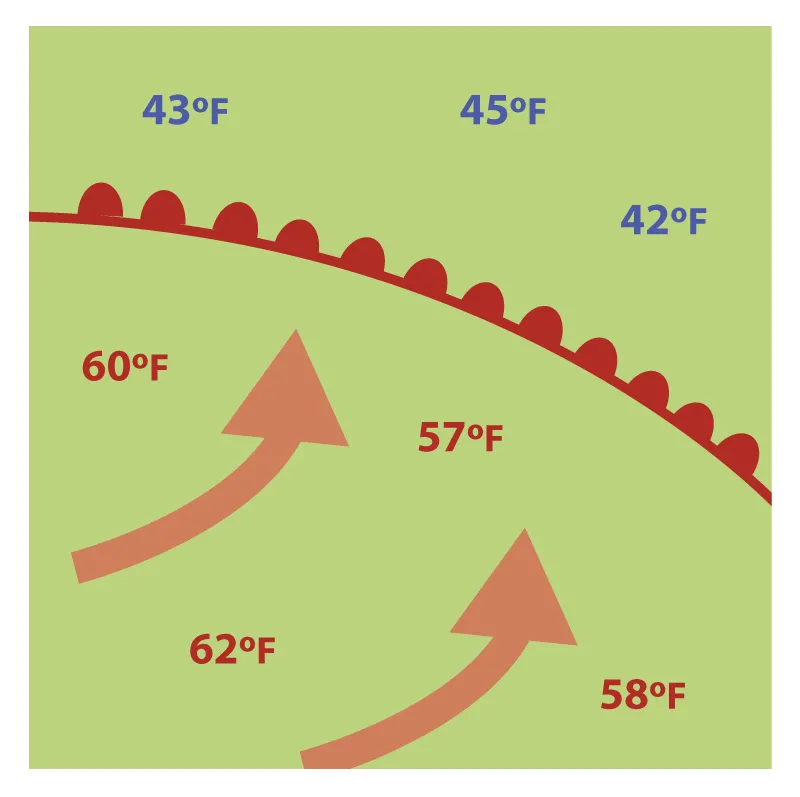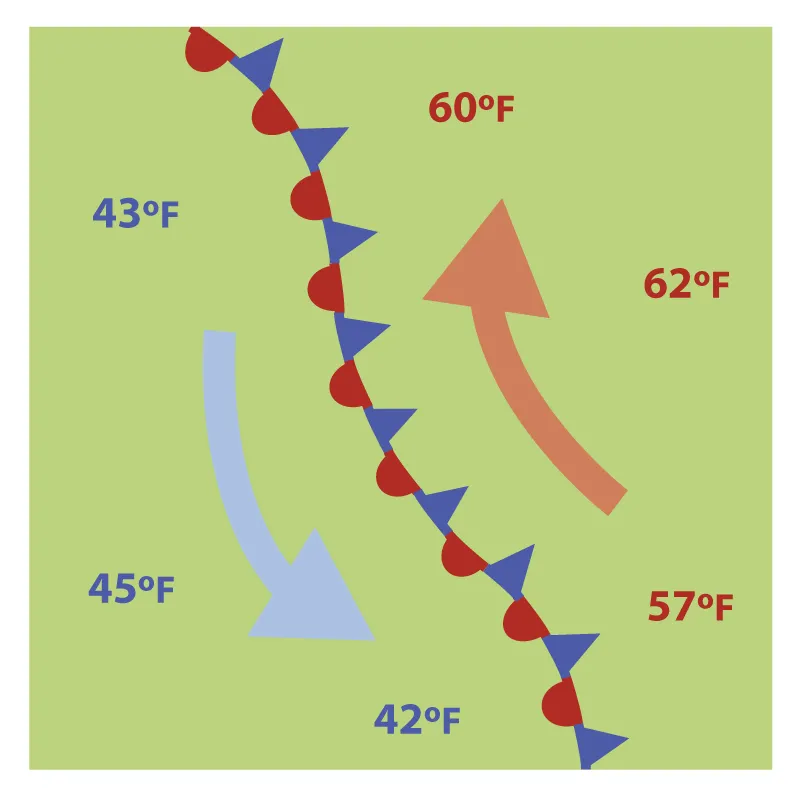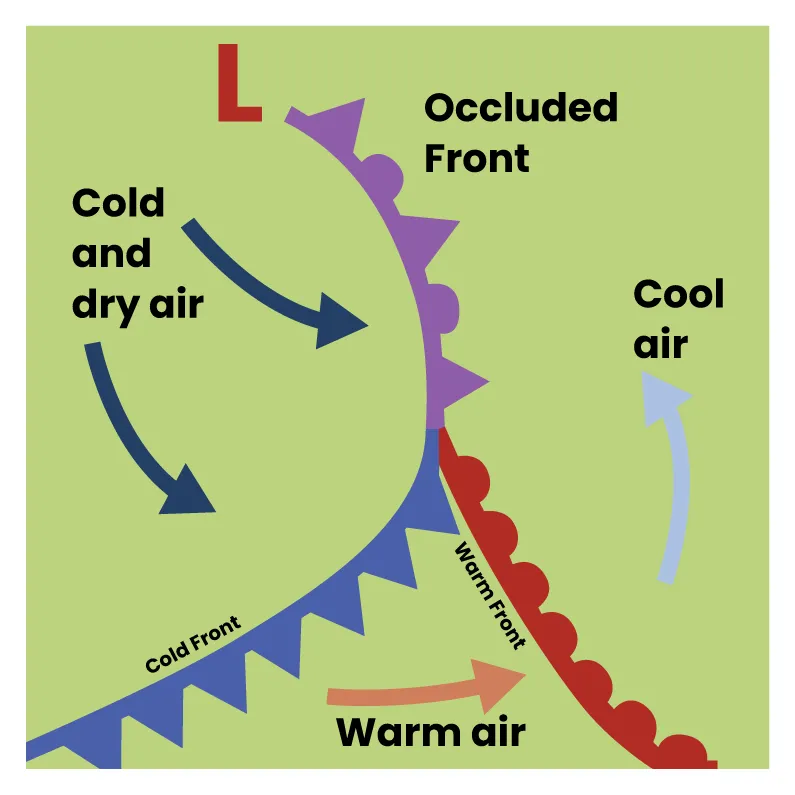Weather Fronts

Storm front over Lake Superior, US.
EPA
When a front passes over an area, it means a change in the weather. Many fronts cause weather events such as rain, thunderstorms, gusty winds, and tornadoes. At a cold front, there may be dramatic thunderstorms. At a warm front, there may be low stratus clouds. Usually, the skies clear once the front has passed.
A weather front is a transition zone between two different air masses at the Earth's surface. Each air mass has unique temperature and humidity characteristics. Often there is turbulence at a front, which is the borderline where two different air masses come together. The turbulence can cause clouds and storms.
Instead of causing clouds and storms, some fronts just cause a change in temperature. However, some storm fronts start Earth's largest storms. Tropical waves are fronts that develop in the tropical Atlantic Ocean off the coast of Africa. These fronts can develop into tropical storms or hurricanes if conditions allow.
Fronts move across the Earth's surface over multiple days. The direction of movement is often guided by high winds, such as Jet Streams. Landforms like mountains can also change the path of a front.
There are four different types of weather fronts: cold fronts, warm fronts, stationary fronts, and occluded fronts.
Cold Front

Weather map showing a cold front. Air temperatures ahead of the front are warmer than temperatures in the cold air mass behind the front.
L.S. Gardiner/UCAR
A cold front forms when a cold air mass pushes into a warmer air mass. Cold fronts can produce dramatic changes in the weather. They move fast, up to twice as fast as a warm front. As a cold front moves into an area, the heavier (more dense) cool air pushes under the lighter (less dense) warm air, causing it to rise up into the troposphere. Lifted warm air ahead of the front produces cumulus or cumulonimbus clouds and thunderstorms.
As the cold front passes, winds become gusty. There is a sudden drop in temperature, and also heavy rain, sometimes with hail, thunder, and lightning. Atmospheric pressure changes from falling to rising at the front. After a cold front moves through your area, you may notice that the temperature is cooler, the rain has stopped, and the cumulus clouds are replaced by stratus and stratocumulus clouds or clear skies.
On weather maps, a cold front is represented by a solid blue line with filled-in triangles along it, like in the map. The triangles are like arrowheads pointing in the direction that the front is moving. Notice on the map that temperatures at the ground level change from warm to cold as you cross the front line.
Warm Front

Weather map showing a warm front. Air temperatures ahead of the front are cooler than temperatures in the warm air mass behind the front.
L.S.Gardiner/UCAR
A warm front forms when a warm air mass pushes into a cooler air mass, shown in the image to the right (A). Warm fronts often bring stormy weather as the warm air mass at the surface rises above the cool air mass, making clouds and storms. Warm fronts move more slowly than cold fronts because it is more difficult for the warm air to push the cold, dense air across the Earth's surface. Warm fronts often form on the east side of low-pressure systems where warmer air from the south is pushed north.
You will often see high clouds like cirrus, cirrostratus, and middle clouds like altostratus ahead of a warm front. These clouds form in the warm air that is high above the cool air. As the front passes over an area, the clouds become lower, and rain is likely. There can be thunderstorms around the warm front if the air is unstable.
On weather maps, the surface location of a warm front is represented by a solid red line with red, filled-in semicircles along it, like in the map on the right (B). The semicircles indicate the direction that the front is moving. They are on the side of the line where the front is moving. Notice on the map that temperatures at ground level are cooler in front of the front than behind it.
Stationary Front

A stationary front is represented on a map by triangles pointing in one direction and semicircles pointed in the other direction.
L.S.Gardiner/UCAR
A stationary front forms when a cold front or warm front stops moving. This happens when two masses of air are pushing against each other, but neither is powerful enough to move the other. Winds blowing parallel to the front instead of perpendicular can help it stay in place.
A stationary front may stay put for days. If the wind direction changes, the front will start moving again, becoming either a cold or warm front. Or the front may break apart.
Because a stationary front marks the boundary between two air masses, there are often differences in air temperature and wind on opposite sides of it. The weather is often cloudy along a stationary front, and rain or snow often falls, especially if the front is in an area of low atmospheric pressure.
On a weather map, a stationary front is shown as alternating red semicircles and blue triangles. Notice how the blue triangles point in one direction, and the red semicircles point in the opposite direction.
Occluded Front

An occluded front may share the characteristics of both warm and cold fronts. Occluded fronts are denoted by a line with both semicircles and triangles and are often colored purple on a weather map.
UCAR Center for Science Education
Sometimes a cold front follows right behind a warm front. A warm air mass pushes into a colder air mass (the warm front), and then another cold air mass pushes into the warm air mass (the cold front). Because cold fronts move faster, the cold front is likely to overtake the warm front. This is known as an occluded front.
At an occluded front, the cold air mass from the cold front meets the cool air that was ahead of the warm front. The warm air rises as these air masses come together. Occluded fronts usually form around areas of low atmospheric pressure.
There is often precipitation along an occluded front from cumulonimbus or nimbostratus clouds. Wind changes direction as the front passes and the temperature either warms or cools. After the front passes, the sky is usually clearer, and the air is drier.
On a weather map, shown to the right, an occluded front looks like a purple line with alternating triangles and semicircles pointing in the direction that the front is moving. It ends at a low pressure area shown with a large ‘L’ on the map, begins at the other end when cold and warm fronts connect.